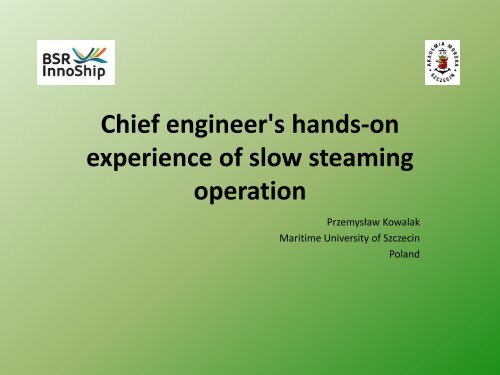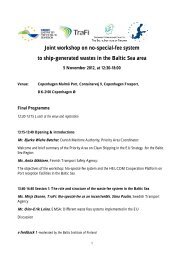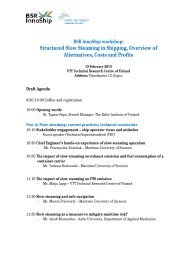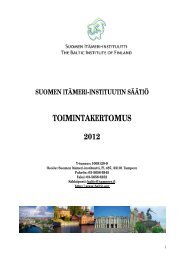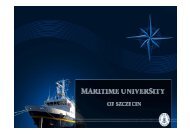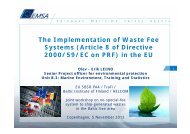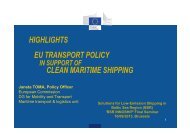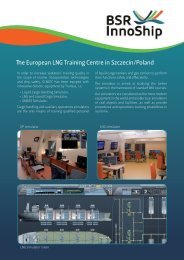Chief Engineer's Hands-on Experience of Slow Steaming Operation
Chief Engineer's Hands-on Experience of Slow Steaming Operation
Chief Engineer's Hands-on Experience of Slow Steaming Operation
Create successful ePaper yourself
Turn your PDF publications into a flip-book with our unique Google optimized e-Paper software.
<str<strong>on</strong>g>Chief</str<strong>on</strong>g> engineer's hands-<strong>on</strong><br />
experience <strong>of</strong> slow steaming<br />
operati<strong>on</strong><br />
Przemysław Kowalak<br />
Maritime University <strong>of</strong> Szczecin<br />
Poland
The presentati<strong>on</strong> agenda<br />
• Potential benefits <strong>of</strong> slow steaming<br />
• Potential detriments <strong>of</strong> slow steaming<br />
• Different modes <strong>of</strong> slow steaming<br />
• Technical challenges for the main engine<br />
• Technical challenges for auxiliaries<br />
• Technical challenges for ship’s hull<br />
• Technical challenges for the crew<br />
• Summary
<strong>Slow</strong> steaming beneficiaries<br />
Charterer Technical operator Ship’s crew Enviroment<br />
• Lower ME fuel<br />
c<strong>on</strong>sumpti<strong>on</strong><br />
per voyage<br />
• Lower bunkering<br />
frequency<br />
per voyage<br />
• Lower average<br />
engine load<br />
• Lower yearly<br />
cylinder oil<br />
c<strong>on</strong>sumpti<strong>on</strong><br />
• Lower bunkering<br />
frequency<br />
• Lower average<br />
engine load<br />
• L<strong>on</strong>ger time<br />
between ports<br />
• Lower NOx impact<br />
per voyage<br />
• Lower CO2 impact<br />
per voyage<br />
• Lower SOx impact<br />
per voyage<br />
• Lower risk <strong>of</strong><br />
fuel spillage<br />
per voyage
<strong>Slow</strong> steaming due detriments<br />
Charterer Technical operator Ship’s crew Enviroment<br />
• L<strong>on</strong>ger voyage<br />
time and<br />
c<strong>on</strong>sequently charter<br />
fee per voyage<br />
• Higher auxiliaries<br />
fuel c<strong>on</strong>sumpti<strong>on</strong><br />
per voyage<br />
• Ship’s hull fouling<br />
• Engaging <strong>of</strong><br />
additi<strong>on</strong>al ship in<br />
the line service<br />
• Higher auxiliaries<br />
working hours<br />
per voyage<br />
• Ship’s hull fouling<br />
• Higher cost<br />
<strong>of</strong> spares<br />
• More frequent<br />
inspecti<strong>on</strong>s<br />
• More frequent<br />
servicing<br />
• Higher auxiliaries<br />
working hours<br />
• Higher CO impact<br />
• Higher PM<br />
c<strong>on</strong>centrati<strong>on</strong><br />
• Higher sludge<br />
impact per voyage
Different modes <strong>of</strong> slow steaming<br />
• Reduced speed.<br />
Range <strong>of</strong> main engine load below the optimisati<strong>on</strong> point down to approx. 60% <strong>of</strong><br />
load. Till the slow steaming era it used to be c<strong>on</strong>sidered as a minimum limit <strong>of</strong><br />
c<strong>on</strong>tinous low load operati<strong>on</strong> for a large marine engines.<br />
• Moderate slow steaming.<br />
The auxiliary blowers may cut-in periodically for a short time when approaching to<br />
lower limit <strong>of</strong> this load range. The auxiliary boiler is cut-<strong>of</strong>f. Typical load range 60-40<br />
% <strong>of</strong> MCR.<br />
relative engine load [% MCR]<br />
100<br />
90<br />
80<br />
70<br />
60<br />
50<br />
40<br />
30<br />
20<br />
10<br />
Standard optimisati<strong>on</strong> point<br />
Reduced speed range<br />
Moderate slow steaming range<br />
Deep slow steaming range<br />
Ultra slow steaming range<br />
0<br />
0 10 20 30 40 50 60 70 80 90 100<br />
relative engine speed [% n n ]
Different modes <strong>of</strong> slow steaming<br />
• Deep slow steaming.<br />
The auxiliary blowers are in service and auxiliary boiler may frequently cut-in to<br />
boost poor performance <strong>of</strong> ec<strong>on</strong>omiser. Load range approx. 40% <strong>of</strong> MCR down to 20-<br />
25% <strong>of</strong> MCR<br />
• Ultra slow steaming.<br />
The auxiliary blowers and auxiliary boiler are in service. Insufficient waste heat to<br />
operate fresh water generator. Load range below 20-25% <strong>of</strong> MCR down to approx.<br />
10% <strong>of</strong> MCR<br />
relative engine load [% MCR]<br />
100<br />
90<br />
80<br />
70<br />
60<br />
50<br />
40<br />
30<br />
20<br />
10<br />
Standard optimisati<strong>on</strong> point<br />
Reduced speed range<br />
Moderate slow steaming range<br />
Deep slow steaming range<br />
Ultra slow steaming range<br />
0<br />
0 10 20 30 40 50 60 70 80 90 100<br />
relative engine speed [% n n ]
What <strong>on</strong> board can be affected by slow steaming<br />
1) Main engine<br />
2) Auxiliary machinery<br />
3) Ship’s hull<br />
4) The crew
Main Engine<br />
Cylinder oil dosage and c<strong>on</strong>sumpti<strong>on</strong><br />
As a rule <strong>of</strong> thumb all modern cylinder oil dosage systems relate amount <strong>of</strong> oil with the engine<br />
load and fuel sulfurisati<strong>on</strong> based <strong>on</strong> general formula:<br />
CylOil= S% ∙ %MCR ∙ k<br />
Where:<br />
CylOil – cylinder oil dosage [g/kWh]<br />
S% – percentage <strong>of</strong> sulphur in fuel<br />
%MCR – relative engine load<br />
k – empirical dosage factor<br />
The general expectati<strong>on</strong> is that the cylinder oil c<strong>on</strong>sumpti<strong>on</strong> will decrease after slow<br />
steaming implementati<strong>on</strong>.<br />
9<br />
8<br />
7<br />
Cylinder Oil c<strong>on</strong>sumpti<strong>on</strong> for 4250 TEU PanaMAX C<strong>on</strong>tainer Carrier<br />
CylOil [g/kWh]<br />
6<br />
5<br />
4<br />
3<br />
2<br />
1<br />
0<br />
0 10 20 30 40 50 60 70 80 90<br />
% MCR
Cylinder Oil c<strong>on</strong>sumpti<strong>on</strong> for 4250 TEU PanaMAX C<strong>on</strong>tainer Carrier<br />
2,0<br />
1,8<br />
1,6<br />
Main Engine<br />
Cylinder oil dosage and c<strong>on</strong>sumpti<strong>on</strong><br />
CylOil [kg/Nm]<br />
1,4<br />
1,2<br />
1,0<br />
0,8<br />
0,6<br />
0,4<br />
0,2<br />
6 8 10 12 14 16 18 20 22 24<br />
Vessel speed [kn]<br />
Cylinder Oil c<strong>on</strong>sumpti<strong>on</strong> for 4250 TEU PanaMAX C<strong>on</strong>tainer Carrier<br />
180<br />
10<br />
Let’s simulate: vessel is employed <strong>on</strong> a<br />
South America – Europe trade with 11800<br />
Nm distance per trip and total 8 ports,<br />
where she spends average 400 hrs per trip.<br />
The yearly cylinder oil c<strong>on</strong>sumpti<strong>on</strong> will<br />
depends <strong>on</strong> the vessel speed:<br />
Yearly c<strong>on</strong>sumpti<strong>on</strong> [T<strong>on</strong>/year]<br />
160<br />
140<br />
120<br />
100<br />
80<br />
60<br />
40<br />
9<br />
8<br />
7<br />
6<br />
5<br />
4<br />
Number <strong>of</strong> trips<br />
20<br />
3<br />
4 6 8 10 12 14 16 18 20 22 24<br />
Vessel speed [kn]
Main Engine<br />
Cylinder oil overdosing – the c<strong>on</strong>sequences<br />
Surplus oil burns into hard<br />
coke, resulting in fast<br />
abrasive wear down <strong>of</strong> liner<br />
and pist<strong>on</strong> rings.<br />
Surplus unburnt oil flows down in a<br />
form <strong>of</strong> blackish sludge<br />
resulting in pist<strong>on</strong> rings clogging and<br />
blocking as well as increasing <strong>of</strong> fire in<br />
scavenge space risk.
Main Engine<br />
low temperature corrosi<strong>on</strong><br />
The main factors triggering low temperature corrosi<strong>on</strong>:<br />
• Low exhaust gas temperature<br />
• High humidity <strong>of</strong> charging air<br />
• Low HT cooling water temperature<br />
• Low charging air temperature<br />
Overcooled area <strong>of</strong> cylinder liner is exposed to water<br />
c<strong>on</strong>densati<strong>on</strong> and formati<strong>on</strong> <strong>of</strong> acids.<br />
How do we deal with it <strong>on</strong> board:<br />
• Water mist catcher after charging air cooler inspecti<strong>on</strong>s<br />
• Rising cooling water temperature<br />
• Rising charging air temperature<br />
• C<strong>on</strong>trol <strong>of</strong> cylinder oil dosage
Main Engine<br />
Fuel valve fouling<br />
Typical TBO for 2-stroke engines is 16000 rh and for 4-stroke engines is 8000 rh. Due to c<strong>on</strong>taminati<strong>on</strong><br />
<strong>of</strong> the nozzle tip it may be reas<strong>on</strong>able to reduce it by 1000-4000 based <strong>on</strong> observati<strong>on</strong>s.<br />
Fuel valves TBO [m<strong>on</strong>ths]<br />
20<br />
19<br />
18<br />
17<br />
16<br />
15<br />
14<br />
13<br />
Fuel valves TBO for vessel w ith medium speed main engine<br />
Due to l<strong>on</strong>ger time at sea when<br />
slow steaming, the overhauling<br />
frequency <strong>of</strong> some machinery will<br />
increase. It must be taken into<br />
account into a maintenance plan.<br />
Also amount <strong>of</strong> work the crew is<br />
burden increase significantly.<br />
12<br />
4 6 8 10 12 14 16 18 20 22 24<br />
Vessel speed [kn]
Main Engine<br />
Periodical engine’s loading up<br />
Advantages:<br />
• Allows to blow away accumulated deposits<br />
• Allows to burn soot<br />
• Allows to test the engine readiness at higher load<br />
Disadvantages:<br />
• Increases daily average fuel c<strong>on</strong>sumpti<strong>on</strong><br />
• Causes additi<strong>on</strong>al thermal load<br />
• Additi<strong>on</strong>ally c<strong>on</strong>sumes pers<strong>on</strong>nel time<br />
• May lead to unexpected machinery failure during<br />
accelerati<strong>on</strong>
Main Engine<br />
Turbine washing<br />
Two stroke engines:<br />
• Dry or wet washing can be applied<br />
• Usually c<strong>on</strong>ducted during sea passage<br />
• Wet washing requires load reducti<strong>on</strong><br />
down to approx. 20-25 % MCR<br />
• Dry washing requires loading up to<br />
approx. 70-80 % MCR<br />
Four stroke engines:<br />
• Wet washing can be applied <strong>on</strong>ly<br />
• Usually c<strong>on</strong>ducted at berth prior departure<br />
• Standard MAK recomendati<strong>on</strong>: compressor<br />
every 24 RH at full load (minimum 50%<br />
MCR). Turbine every 150 RH at low load<br />
Low engine load means either that the engine<br />
- is running either, at zero pitch and rated speed<br />
- or, <strong>on</strong> the grid at rated speed and a max. <strong>of</strong> 10 %<br />
load<br />
- or, disengaged at rated speed.<br />
In all cases the compressor side wet cleaning requires engine loading up.
Main Engine<br />
Turbine washing<br />
The hazard:<br />
• Corrosi<strong>on</strong> <strong>of</strong> exhaust duct<br />
• Abrassive wear <strong>of</strong> nozzle ring<br />
• Thermal stress<br />
• EU regulati<strong>on</strong> for SOx emissi<strong>on</strong> at berth<br />
must be taken into account when<br />
planned in European port
The observati<strong>on</strong>s:<br />
Main Engine<br />
Auxiliary blowers<br />
• Frequent cut-in/cut <strong>of</strong>f at certain engine loads,<br />
usually close to 40 % MCR<br />
• C<strong>on</strong>tinous operati<strong>on</strong> below approx. 40 % MCR<br />
The following problems were defined:<br />
• Electric motor and blower itself are not designed for c<strong>on</strong>tinous operati<strong>on</strong> – risk <strong>of</strong> failure.<br />
• Electric motor and blower itself are not designed for frequent starts – risk <strong>of</strong> failure.<br />
• Due to size <strong>of</strong> motors their sudden start may cause n<strong>on</strong>essential c<strong>on</strong>sumers trip.<br />
• Sudden change <strong>of</strong> weather c<strong>on</strong>diti<strong>on</strong>, sea current, alterati<strong>on</strong> <strong>of</strong> the vessel course or<br />
speed setting when engine room is not manned may lead to above menti<strong>on</strong>ed.<br />
How do we deal with them <strong>on</strong> board:<br />
• Set <strong>of</strong> spares and/or preferably complete blower with motor is to be kept <strong>on</strong> board.<br />
• We avoid ~40 % MCR load for c<strong>on</strong>tinous operati<strong>on</strong>.<br />
• We set blowers in manual mode <strong>on</strong>.<br />
• We agree with master 12 hrs operati<strong>on</strong> at load above 40 % MCR and 12 hrs below this load.
The heating plant<br />
Boiler c<strong>on</strong>taminati<strong>on</strong><br />
Due to low velocity <strong>of</strong> exhaust gas and poor atomizati<strong>on</strong> as well<br />
as combusti<strong>on</strong> process, amount <strong>of</strong> deposits in smoke tubes<br />
increases drastically.<br />
Under low ME load the ec<strong>on</strong>omizer heating capacity becomes<br />
insufficient. In order to maintain steam pressure/thermal oil<br />
temperature the auxiliary boiler cuts-in usually below main<br />
engine’s load 30 % to 40 % MCR when the ec<strong>on</strong>omizer is clean.<br />
The auxiliary boiler cut-in set point reducti<strong>on</strong> by 1-3 bar may be<br />
c<strong>on</strong>sidered.<br />
Dirty ec<strong>on</strong>omizer brings the auxiliary boiler about to cut-in at<br />
higher main engine’s load than 40 % MCR.<br />
Prol<strong>on</strong>ged auxiliary boilers operati<strong>on</strong> during sea voyage causes its<br />
additi<strong>on</strong>al c<strong>on</strong>taminati<strong>on</strong> and c<strong>on</strong>sequently much higher fuel<br />
c<strong>on</strong>sumpti<strong>on</strong>.<br />
High risk <strong>of</strong> soot igniti<strong>on</strong> can not be underestimated in any case.
The heating plant<br />
C<strong>on</strong>taminati<strong>on</strong> – how we deal with it<br />
Installati<strong>on</strong> and proper functi<strong>on</strong>ing <strong>of</strong><br />
soot igniti<strong>on</strong> catalyst dosing plant is<br />
essential.<br />
However if exhaust gas temperature<br />
after turbine drops below 200-220⁰C<br />
their efficiency is disputable.<br />
Frequent engine’s loading up and boiler water washing seems to be most effective in reducti<strong>on</strong> <strong>of</strong><br />
deposits. However…<br />
200-300 kg <strong>of</strong> deposits can be accumulated in smoke tubes<br />
over period <strong>of</strong> 4 m<strong>on</strong>ths between washing (boiler’s<br />
nominal steam output 1700kg/hr).<br />
• Boiler plant has to be stopped<br />
for at least 12-16 hrs for proper<br />
cooling down, washing and<br />
heating up;<br />
• It will be generated lots <strong>of</strong><br />
garbage and dirty water<br />
• Rinsing water is highly<br />
corrosive. Damage to the<br />
draining system is unavoidable<br />
even if neutralizers are being<br />
dosed.
Technical challenges for auxiliary machinery<br />
Fresh water generati<strong>on</strong><br />
The observati<strong>on</strong>:<br />
At deep and/or ultra slow steaming there is<br />
insufficient heat from main engine<br />
for fresh water generati<strong>on</strong>.<br />
How do we deal with it <strong>on</strong> board:<br />
• Vessel has to take fresh water in ports<br />
what creates additi<strong>on</strong>al costs.<br />
• In some systems it is possible to run ME<br />
cooling water preheaters as heating booster.<br />
The disadvantages:<br />
• Fresh water from shore is <strong>of</strong>ten <strong>of</strong> poor quality<br />
and harder than produced <strong>on</strong> board.<br />
• Additi<strong>on</strong>al fuel c<strong>on</strong>sumpti<strong>on</strong> will be observed<br />
if auxiliary boiler cuts-in.
A few facts at beginning:<br />
The observati<strong>on</strong>s:<br />
Technical challenges for auxiliary machinery<br />
Sludge system<br />
• The biggest source <strong>of</strong> sludge<br />
are fuel oil separators indeed.<br />
• Modern separators activate desludging<br />
by detected c<strong>on</strong>taminati<strong>on</strong> or by timer – what is first.<br />
• Singular separator’s capacity usually covers at least 60-70 %<br />
<strong>of</strong> entire ships maximum fuel c<strong>on</strong>sumpti<strong>on</strong>.<br />
• Separator’s throughput regulati<strong>on</strong><br />
is <strong>of</strong>ten impossible or difficult to achieve.<br />
• The charterers or owners pay for sludge collecti<strong>on</strong><br />
so they expect minimum quantity <strong>of</strong> produced sludge.<br />
• The previously used estimati<strong>on</strong> that 1.5% <strong>of</strong> c<strong>on</strong>sumed<br />
fuel turns into sludge is not valid any more and this fact<br />
has to be accepted.<br />
Amount <strong>of</strong> oily deposits related to fuel c<strong>on</strong>sumpti<strong>on</strong>,<br />
generated by slow steaming vessel, increase.
The observati<strong>on</strong>s:<br />
• Ship’s hull is coated with an antifouling<br />
painting designed for a specific range <strong>of</strong><br />
speed.<br />
Technical challenges for ship’s hull<br />
Fouling<br />
• If the vessel’s speed is prol<strong>on</strong>ged time outside<br />
the designed range the protecti<strong>on</strong> may be not<br />
effective.<br />
• Due to reduced rotati<strong>on</strong> speed the propeller is<br />
more vulnerable to fouling as well.<br />
How to deal with:<br />
• The charterers or owners have to c<strong>on</strong>sider<br />
more frequent underwater surveys and surplus<br />
ships hull cleaning.<br />
• Periodical propeller underwater polishing<br />
might be helpfull.
Challenges for the crew<br />
Most <strong>of</strong> the ships is manned with a minimum<br />
crew. Very <strong>of</strong>ten not more than stated in<br />
Minimum Safe Manning Certificate.<br />
<strong>Slow</strong> steaming demands more additi<strong>on</strong>al<br />
activities and attenti<strong>on</strong> from the crew,<br />
especially:<br />
• More frequently inspecti<strong>on</strong>s.<br />
• More frequently cleaning and washing.<br />
• More frequently servicing.<br />
• Every day preventive activities.<br />
There are advantages for the crew as well:<br />
• L<strong>on</strong>ger passage between ports (especial in westeast<br />
directi<strong>on</strong>).<br />
• Less frequent bunkers.<br />
• Less frequent maneuverings.
Summary<br />
<strong>Slow</strong> steaming became a widely utilized way <strong>of</strong> cost reducti<strong>on</strong> in shipping and it has been<br />
accepted by major engine builders. Therefore it has to be accepted by engineers <strong>on</strong><br />
board. However…<br />
• Vessel operators has to understand that the additi<strong>on</strong>al maintenance requires an additi<strong>on</strong>al<br />
time.<br />
• Some <strong>of</strong> maintenance procedures requires predictable prol<strong>on</strong>ged berthing or safe anchorage.<br />
• Some <strong>of</strong> preventive maintenance requires additi<strong>on</strong>al c<strong>on</strong>sumables (chemicals, spares etc.).<br />
• In some cases, additi<strong>on</strong>al manpower might be required in order to c<strong>on</strong>duct slow steaming<br />
related services together with standard service and running the ship.<br />
• Prol<strong>on</strong>ged slow steaming without intermittent periods with higher load will deteriorate the<br />
whole ships performance and will decrease initial pr<strong>of</strong>its.<br />
The recommendati<strong>on</strong>s:<br />
• Good cooperati<strong>on</strong> between charterer, technical operator and well trained crew is essential.<br />
• Whenever possible periodical short passages at higher vessel speed should be arranged.<br />
• Vessel should be given necessary time for c<strong>on</strong>ducting maintenance.


